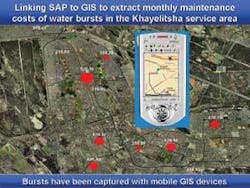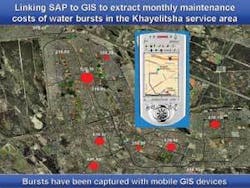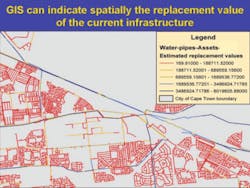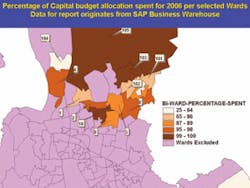Cape Town’s Emphasis on Systems Integration Exemplifies ‘Smart City’ Goals
Use of GIS and SAP technologies by the city of Cape Town, South Africa, has been implemented in various departments, including water/wastewater.
In 2001, seven neighboring local authorities were amalgamated into the city of Cape Town in the Republic of South Africa with the intention of consolidating and streamlining municipal services across the Cape Town metropolitan area. As a result of this massive restructuring process, the city, with a population of approximately 3.2 million, immediately became responsible for managing a number of antiquated, standalone information management systems holding disparate data in at least seven different information technology (IT) centers across the new city.
Integrating its existing legacy systems into a seamless IT infrastructure became a top priority for the city. Committing itself to a holistic and comprehensive “smart city” strategy, the IT department initiated a number of projects to address the standardization of Information and Communications Technology (ICT) architecture and connection of constituent parts to enable a better flow of information among departments and more efficient services for its residents.
Key to success of the smart city strategy was implementation of the enterprise resource planning (ERP) system, which saw about 113 legacy systems and 70 interfaces replaced with a single, functionally rich SAP solution designed to standardize and optimize the city’s entire business processes. Recognized as one of the world’s largest ERP systems ever implemented by a local government, it has a custom-designed billing system to help streamline the accounting process.
Next, Cape Town integrated a geographic information system (GIS) into the information system infrastructure. While GIS technology was used throughout various local councils prior to the amalgamation, it functioned primarily as standalone systems with little standardization and limited compatibility. To reform this particular legacy, the city implemented an enterprise GIS based on ESRI’s ArcGIS platform. This allowed extensive functionality within a multi-user environment and provided an effective spatial data management platform for its many users. Initially, the city concentrated on consolidating electricity and property geodatabases into the GIS, and subsequently added the Water Services geodatabase to the GIS process. Since then, a number of other departments, such as Planning and Valuations, have started implementing GIS technology. ArcGIS was successfully implemented into participating departments as the city focused on integration issues, such as user profiles, as well as standardized data capturing and maintenance of departmental geodatabases.
Cape Town’s Water Services proved to be the ideal utility from which to continue its GIS integration initiatives. South Africa is in a semiarid region without significant perennial rivers or lakes, and this reality requires extensive conservation and water control measures. The city also experiences 3% annual growth in its population, placing an even greater strain on its limited water resources. Given these constraints, GIS provides one of the best possible means to collect, analyze and model spatial data for optimization of water conservation and demand strategies.
SAP enabled the city to establish an effective link between the system’s business information capabilities and its location-based asset information such as pipes, meters, reservoirs, treatment plants, and associated attribute data stored in GIS. By taking advantage of this linkage, Cape Town is now able to extract the monthly maintenance costs for incidents, such as burst pipes and sewer blockages, as well as to evaluate water consumption patterns based on tariff structures.
There’s also a link to the asset register, which is a model that runs against the GIS infrastructure geodatabase and is used to calculate solutions such as the life span of the various parts and components of the Water Services’ infrastructure. GIS can, therefore, be used as a tool to plan medium- and long-term budgeting of infrastructure projects such as replacing pipe infrastructure due to increased population demands or end of life cycle redundancy. Next, the city will apply the lessons learned from the Water Services implementation to development of a sewer and stormwater geodatabase. Currently, the existing ArcEditor/ArcInfo 9.1 tools are utilized for multi-user editing in eight district offices, but the long-term vision is to develop a customized editing tool within the ArcGIS Server environment.
By developing a common data model for GIS use throughout the city, Cape Town has realized substantial savings in its operations and developed a GIS that promotes data sharing while minimizing data redundancy. The overall strategy is to implement a GIS completely integrated with the city’s enterprise-wide information architecture and infrastructure, providing support to the city’s private citizens and its local business community.
The Water Services Department has also implemented a Technical Operations Centre (TOC) that interfaces with the Corporate Call Centre to initiate operational responses and manage event tracking and logging. And it’s evaluating available technology and interfacing options to develop a fully automated, spatially enabled event management system (EMS), defining an event as any operational activity requiring a response. The EMS would be used to monitor and support responsibilities of the city’s employees to increase efficiency. For example, the EMS would automatically record the exact location of an event occurring in the city and analyze it to determine its impact on the surrounding area. Using location as a reference, the system would then identify assets the city has at any particular spot and dispatch work crews to respond to the event. Workflows developed within the EMS will allow the city to define and manage its standard operating procedures (SOPs) to support the EMS. Workflows would analyze the system’s automated response to an event and escalate the response to a higher level, demanding greater urgency, if required.
According to Pieta le Roux, Water Services Department GIS coordinator, because events will be spatially referenced, engineers will be able to interpret trends and patterns visually, which will allow them to be proactive in their response to events. In addition, the TOC will coordinate responses to water/wastewater emergencies by integrating notification and work order processes of SAP with mobile GPS/GIS and communication technologies. This integration will allow the city’s supervisory control and data acquisition (SCADA) and telemetry systems’ alarm components to be part of the central IT network and information infrastructure for quicker response to any malfunctions or anomalies occurring within the city’s utility networks.
Further, Le Roux said the city of Cape Town has a mature GIS, which is commonly viewed as central to the city administration’s plans for a tightly integrated and service-oriented IT architecture, supported by a modern infrastructure, for a seamless enterprise information management capability. The GIS production and geodatabase server environments form a major part of this integration process.
Commenting on the future, he added, “Cape Town will be implementing strategies and processes toward the transactional integration of GIS and SAP to provide the necessary lifecycle views and real-time feedback of their asset maintenance environment.”
Author’s Note:
Jim Baumann writes about international GIS-related topics for ESRI. He has written articles on various aspects of the computer graphics industry and information technology for more than 20 years. Contact: 909-793-2853, [email protected] or www.esri.com
South Africa Expects Growth
Two recent Frost & Sullivan reports focus on aspects of the water industry in South Africa, pointing to continued growth opportunities:
• South African Municipal Water and Wastewater Treatment Equipment End-User Analysis - “South Africa is set to spend in excess of $50 billion as the Accelerated and Shared Growth Initiative - South Africa (ASGISA) program unfolds in the next two to three years,” notes research analyst Moses Duma. “While this money will be used to develop a number of social amenities including water and wastewater treatment plants, South African municipalities are also set to increase water capacities to take care of the anticipated influx of people during the Soccer World Cup in 2010.”
• South African Desalination Plant Markets - “Water supply shortages, an increasing population and growth in the industrial sector (particularly mining) are key factors driving demand for water in South Africa,” according to research analyst David Winter. “Municipal water managers, especially in coastal areas, are actively seeking alternative technologies and water sources such as desalination to solve current, as well as anticipated water shortages.” Revenues of $23.1 million in 2006 are expected to reach $69.7 million in 2013.



